About Falcons
3 Five Senses
Lauren Weiss
Sight
A peregrine falcon’s vision is eight times better than that of humans. They can spot small prey from 2 miles away.
Falcons have three eyelids. The top and bottom eyelids are white. The third eyelid is a nictitating membrane (NICK-tih-tay-ting MEM-brane) that protects and moistens their eyes. It is translucent so they can still see when it’s closed. This helps them especially when they are flying very fast.
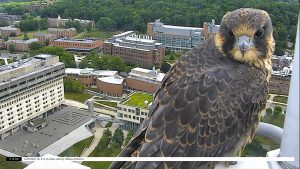
Like other birds of prey, a falcon’s eyes are towards the front of its head, so it has to turn its head to see behind it. However, the birds that they eat, like pigeons, have eyes on the sides of their heads, so they can focus on what they’re doing and also keep a lookout for predators at the same time in case they need to flee. Tom Ricardi, a raptor rehabilitator who takes care of injured raptors, likes to teach a special saying he heard from a student to help remember that: “Eyes in the front, they hunt. Eyes on the side, they hide.”
Hearing
Birds don’t have external ear structures like humans and other mammals. Their ear openings are hidden under the feathers on either side of their head.
A falcon’s hearing is good, but not as strong as its sight, because it relies primarily on its vision to hunt.
Falcons are silent while hunting, but make various sounds at other times. When bonding with their mate, they make special chirping noises. Females will also caw to the males to bring them food while they are nesting. Chicks will also caw to their parents for food once they hatch, and especially as they get older. Additionally, falcons will issue a warning caw to intruders to their territory.
Smell
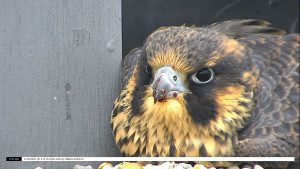
Falcons don’t have a prominent nose like humans or other animals, but they do have nostrils (also called nares) on their ceres. Interestingly, they also have special nasal glands from which they sneeze out a mist of sodium chloride (salt) to help regulate the sodium and chloride content in their bodies, since they can’t get rid of it by urinating.[1]
A falcon’s sense of smell is very basic, since they rely on their vision to hunt. This is unlike other raptors like vultures, who rely heavily on their sense of smell.
Taste
A falcon’s sense of taste is also fairly basic. Falcons do not have as many taste buds as humans.
Touch
Falcons use their sense of touch quite a bit.
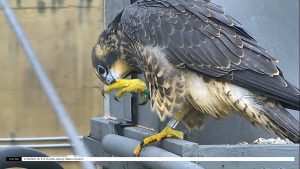
They use their talons to grip perches and prey, and even scratch an itch.
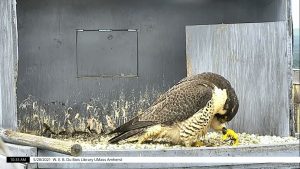
They use their beaks to preen their feathers, which means cleaning arranging, and oiling their feathers to keep them in good condition. They rub their beaks on an oil gland at the top base of their tail and rub the oil on their feathers.
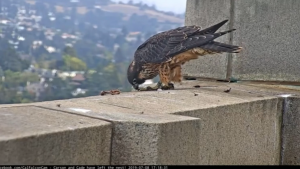
They also rub their beaks against other surfaces to clean or wipe it and maintain beak shape. This is called feaking.
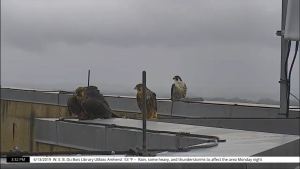
They also use their wings and spread them over prey to protect it from rivals, including siblings. This is called mantling.
Media Attributions
- Eyes in the front, they hunt. © UMass Amherst Libraries is licensed under a CC BY (Attribution) license
- Closeup of Juvenile Falcon © University of Massachusetts Amherst Libraries is licensed under a CC BY (Attribution) license
- Talons © UMass Amherst Libraries is licensed under a CC BY (Attribution) license
- Preening © UMass Amherst Libraries is licensed under a CC BY (Attribution) license
- Feaking © Cal Falcons, University of California Berkeley is licensed under a CC BY (Attribution) license
- Mantling © UMass Amherst Libraries is licensed under a CC BY (Attribution) license
- Cade, Tom. Falcons of the World. ↵

